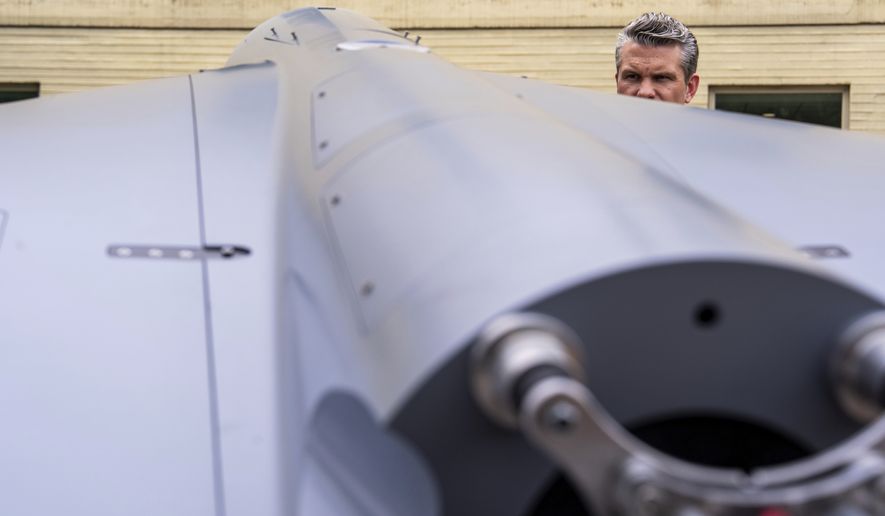The secretive “Replicator” drone program that the Biden administration set up within the Defense Department’s leading tech-industry collaboration unit to accelerate the acquisition and deployment of unmanned systems to U.S. warfighters has a new home under the U.S. Special Operations Command.
The Pentagon told The Washington Times in a statement that the entire Replicator portfolio has officially “transitioned from the Defense Innovation Unit to a newly formed Defense Autonomous Warfare Group (DAWG)” within U.S. Special Operations Command, also known as SOCOM.
The Pentagon provided the statement following The Times’ publication last week of an article examining the effectiveness of the Replicator program, and the extent to which it has succeeded or failed in achieving its goal of fielding “multiple thousands” of attritable autonomous systems by August 2025.
The Times article underscored how the program seems to have fielded only hundreds of drones, although the exact number is classified.
The story of the Replicator program over its 27-month existence has been one of near-unprecedented ambition. But current and former officials said its progress was sometimes slowed by behind-the-scenes turf wars and Pentagon infighting, as well as frustration among some defense industry titans who thought the Defense Innovation Unit was biased in favor of Silicon Valley upstarts.
The Pentagon responded to requests from The Times for comment only after publication of the initial article.
The DAWG is now responsible for Replicator under the direction of Marine Corps Lt. Gen. Francis L. Donovan, according to the Pentagon statement, which said Lt. Gen. Donovan has been named director of the new group by Secretary of Defense Pete Hegseth.
Gen. Donovan was previously assigned as the vice commander of SOCOM by then-Secretary of Defense Lloyd Austin in 2020.
The change relating to Replicator is meant to “ensure rapid procurement and fielding of various drone capabilities to meet specific mission objectives,” according to the statement.
Furthermore, it said the Replicator program has not been used as a template for current modernization and acquisition reforms being pushed by Mr. Hegseth, who outlined some of the reforms in a major speech to defense industry leaders earlier this month.
Replicator was “one of many case studies of how the Department historically would go around the existing system,” the Pentagon statement said.
“The Secretary’s speech and the acquisition transformation he directed seeks to fundamentally change the way the Department does acquisition with the new Warfighting Acquisition System to avoid the need to go around the process in the future,” it said.
Two former defense officials, who spoke on condition of anonymity, criticized Mr. Hegseth’s approach, asserting that the new structure he has created runs the risk of encountering the same types of problems the Replicator program painstakingly worked through the previous year under the Defense Innovation Unit.
One of the former officials told The Times that the new DAWG team would be wise to look at what the group under Replicator in its initial incarnation had done with the Defense Innovation Steering Group and Defense Industry Working Group.
“I hope the DAWG remembers the hard lessons learned by the Replicator team,” the former official said. “Starting with the reality that traditional primes often can’t ramp production capacity quickly, but VC-backed firms can and will.”
Several new, advanced-tech companies on the U.S. defense industrial landscape are competing for Pentagon drone contracts, including Anduril, Shield AI, Zone 5, Saronic and others.
Those newer companies have voiced an emerging ethos of designing military equipment meant to be manufactured by readily available current assembly line processes. That idea is on the verge of being tested, as many of the new hybrid contractors look toward final testing of advanced products next year before full-scale production.
Replicator had a hand in establishing the need for that approach, as well as emphasizing the need for dual-use technologies. Now, the new structure — DAWG — lives inside the much smaller community of SOCOM, with heavy involvement by the U.S. Navy SEALs and the Office of Naval Research.
The Trump administration refers to the Defense Department as the “Department of War,” a secondary name created by a presidential executive order but not yet ratified by Congress.
The Pentagon told The Times that Defense Deputy Secretary Stephen Feinberg is working “in partnership” with acting Defense Innovation Unit Director Undersecretary of Defense for Research and Engineering Emil Michael and Gen. Donovan to ensure that Replicator’s goals move forward.
Mr. Hegseth’s “war of bureaucratic attrition,” as the secretary described it in his recent speech, is nearing its first major hurdle, according to experts. The 2026 National Defense Authorization Act, which both chambers of Congress have passed individually and are now working on a final combined text for, is meant to support the new accelerated acquisitions approach.
Both the House’s Streamlining Procurement for Effective Execution and Delivery (SPEED) Act and the Senate’s Fostering Reform and Government Efficiency in Defense (FORGED) Act are, according to Congressional lawmakers and staff, meant to drastically increase investment in the types of new technologies the department is currently asking for and testing.
• John T. Seward can be reached at jseward@washingtontimes.com.




Please read our comment policy before commenting.